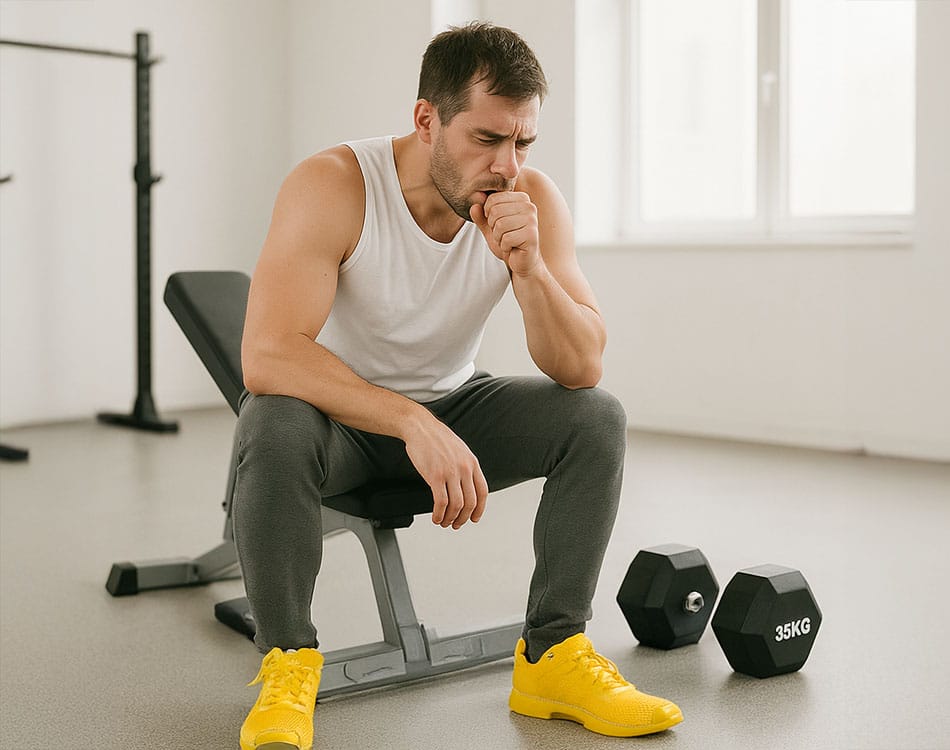Wondering if exercising while sick is safe? Here’s how to tell when to train and when to skip the gym
As flu season arrives, many fitness enthusiasts face a familiar dilemma: should you exercise while ill? Missing workouts due to illness can be frustrating, especially if you’re making great progress towards your fitness goals. However, knowing when it’s safe to train—and when to rest—is essential for your health and recovery.
In this guide, we break down the dos and don’ts of exercising when sick, based on the latest medical advice and fitness recommendations.
The “Neck Test”: A simple guide to deciding whether to exercise
Health professionals often recommend the “neck test” to help you decide. Here’s how it works:
- Symptoms above the neck (such as a runny nose, nasal congestion, sneezing, or a mild sore throat) generally indicate that light exercise is safe.
- Symptoms below the neck (including chest congestion, coughing, fever, muscle aches, or extreme fatigue) are a clear sign to rest and avoid physical activity.
Exercising with mild symptoms
If you choose to exercise despite mild upper respiratory symptoms:
- Reduce the intensity, duration, and volume of your usual workout.
- Pay close attention to how you feel and modify your activity accordingly.
- Opt for light activities such as walking, gentle cycling, or a slow jog.
Warning signs: When to stop exercising
Stop exercising immediately if you experience:
- Chest tightness or pressure
- Difficulty breathing or excessive shortness of breath
- Light-headedness or dizziness
- Loss of balance or coordination
When Your Body Says “No”
If you have a fever (above 38.3°C), chills, body aches, cough, chest congestion, muscle pain, joint pain, or general fatigue, do not exercise. These symptoms suggest a more serious illness, such as the flu or a systemic viral infection.
Why rest is best
Studies conducted on animals have shown that exercising while battling a systemic virus can worsen and prolong symptoms. Some infections can even lead to myocarditis (inflammation of the heart wall), a potentially life-threatening condition that damages heart tissue.
Attempting to “sweat it out” with vigorous exercise while unwell is highly risky and may cause further complications.
Monitor Your Health: Resting Heart Rate as a Clue
A simple way to monitor your health during illness is to check your resting heart rate. Measure it each morning manually or with a wearable device. If your heart rate is 7-10 beats per minute higher than your normal baseline, it may be a sign your body is fighting an infection. In this case, rest is the best option.
Exercising while taking medication: What you should know
If you are taking antibiotics to treat a secondary bacterial infection:
- Avoid exercising until you have completed your course of medication.
- Some antibiotics have been linked to soft tissue injuries, particularly tendon issues.
- Other potential side effects include gastrointestinal upset, fatigue, and photosensitivity (increased risk of sunburn).
- Exercise can place additional strain on a body already working hard to overcome an infection.
Should you exercise when ill?
To summarise:
- Mild “above the neck” symptoms? Light, low-intensity exercise may be safe.
- Severe or “below the neck” symptoms? Rest and recover fully before returning to training.
- Always listen to your body and prioritise long-term health over short-term training gains.















